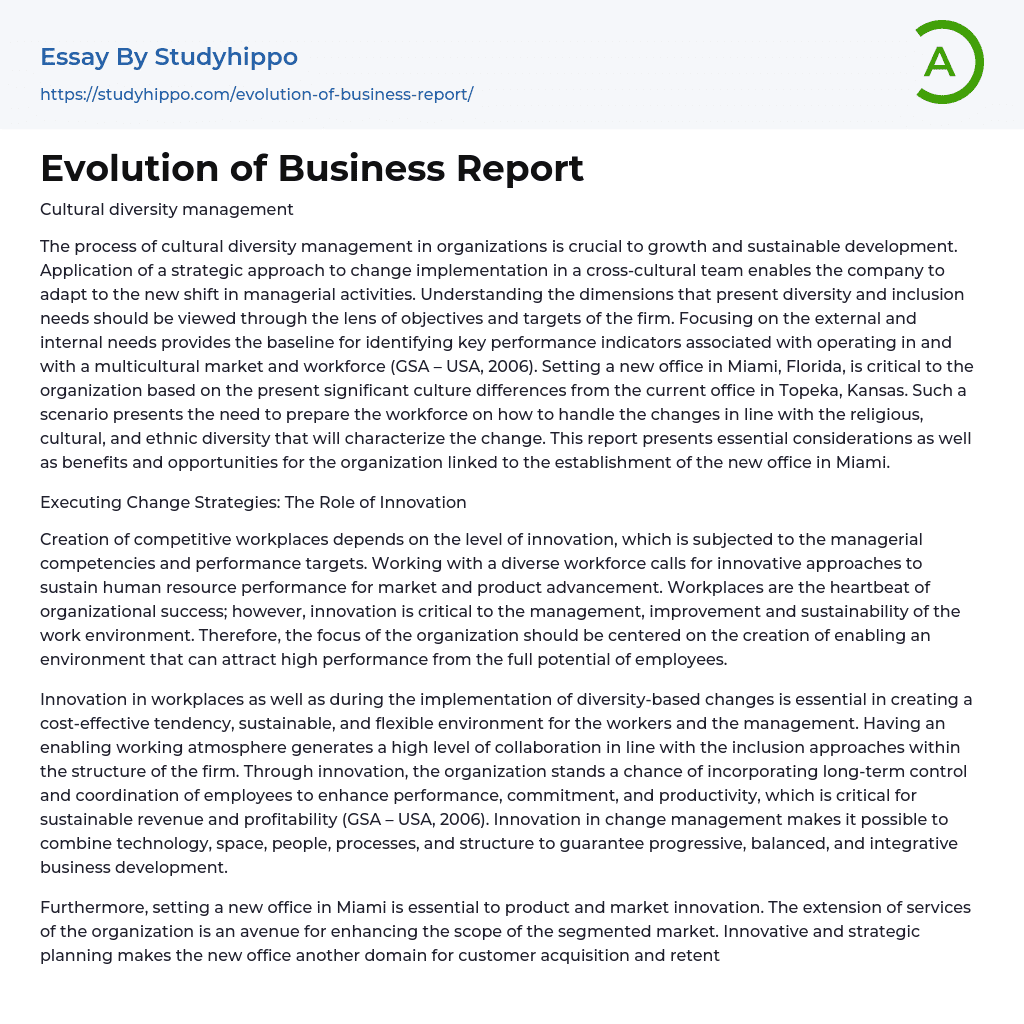Cultural diversity management:
Cultural diversity plays a crucial role in the growth and long-term development of organizations.
In order to successfully implement change in a cross-cultural team, it is essential for the company to adopt a strategic approach. This will enable the company to effectively adapt to new managerial activities and comprehend diversity and inclusion needs. By taking into account the objectives and targets of the firm, both internal and external needs can be addressed. Additionally, key performance indicators associated with operating in a multicultural market and workforce can also be identified (GSA - USA, 2006). The organization acknowledges the significance of establishing a new office in Miami, Florida due to its notable cultural differences compared to the current office in Topeka, Kansas.
The workforce needs to be prepared on how to handle changes that come with religious, cultural, and ethnic diversity that will be present in the establishment
...of the new office in Miami. This report provides essential considerations, benefits, and opportunities for the organization related to the establishment of the new office in Miami.
Executing Change Strategies: The Role of Innovation
The creation of competitive workplaces depends on the level of innovation, which is influenced by managerial competencies and performance targets. Working with a diverse workforce requires innovative approaches to maintain human resource performance for market and product advancement. Workplaces are crucial for organizational success, and innovation is essential for managing, improving, and sustaining the work environment.
Therefore, the organization should focus on creating an environment that attracts high performance from employees. Innovation is crucial in workplaces and when implementing diversity-based changes to create a cost-effective, sustainable, and flexible environment for workers and management. An enabling working atmosphere
promotes collaboration and inclusion within the firm's structure. Through innovation, the organization can control and coordinate employees for enhanced performance, commitment, and productivity, which is vital for sustainable revenue and profitability (GSA – USA, 2006). Innovating change management combines technology, space, people, processes, and structure to ensure progressive and balanced business development. Additionally, establishing a new office in Miami is essential for product and market innovation. Expanding the organization's services enhances the scope of the segmented market.
The new office serves as another avenue for acquiring and retaining customers through innovative and strategic planning. The company's extensive customer service attracts high performance by utilizing product development based on comprehensive market research. It is important to note that innovation provides well-designed workplaces that align with organizational functionality and diversity, serving as a platform for achieving short-term and long-term market performance, customer satisfaction, product development, and cost efficiency (GSA – USA, 2006).
Communication integration in workplaces
Establishing an office in Miami introduces a new composition of workforce. The region has an equal representation of Hispanics and non-Hispanic residents. With a population of over 5.5 million people, the city consists of more than 70% foreign-born citizens. Analysis conducted in learning institutions reveals that Miami encompasses approximately 128 different languages, creating a challenge for integrating communication in workplaces.
The population compositions of Miami and Topeka vary significantly, with Miami experiencing a notable increase in population primarily due to immigration at a rate of 11.1%, while Topeka has a comparatively lower rate of 4.1%. These disparities are depicted in Table 1, which showcases the diversity indicators for each city (Diversity Data, 2015). The following HTML code represents a styled table with multiple rows and
columns. The table incorporates borders, cell padding, and specific styling.
```html
| INDICATOR | MIAMI, FL |
-TOPEKA, KS
--5,762,717 |
|

